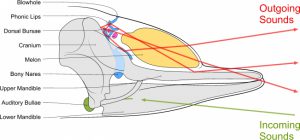
[ms_audio style=”light” mp3=”https://www.dolphincommunicationproject.org/wp-content/uploads/2022/05/TheDolphinPod-2006-08-15-43852.mp3″ ogg=”” wav=”” mute=”” loop=”” controls=”yes” class=”dcp-embed-mp3″ id=””]
A special research news update – the hypothesis that dolphins can use loud bangs or deafening click sounds to debilitate, stun or even kill their prey has been kicking around the scientific world since the 1980s. Learn how new research reveals that this Killer Dolphin Sonar hypothesis is not all that it’s cracked up to be.
Can dolphins kill or stun prey with loud sounds? It certainly seems that way if you believe following headlines: Dolphins’ killer sonar confirmed from ABC Science Online February 2001. Killer clicks from New Scientist 1 January 2001. These are, of course, thrilling headlines and far more interesting than the contents of the research papers that they describe. Why quote the following tedious academic prose: “The propagation of click echoes vis-a-vis the contours and composition of the ensonified object must also be considered when conceptualizing efficacious listening positions” When you can say Mysterious monsters are killing fish with murderous death beams as appeared in The Santa Cruz County Sentinel. However, sometimes reality can indeed live up to the hype – ‘stunning prey with a blast of sound’ is something that happens every day in the ocean. The diminutive snapping shrimp is capable of producing a 200 dB blast using its specially designed claw, rendering unconscious any unsuspecting prey that happen to be passing by. But, can dolphins do something similar? The hypothesis that dolphins can use loud bangs or deafening click sounds to debilitate, stun or even kill their prey has been kicking around the scientific world since the 1980s. It is known as the ‘acoustic prey debilitation’ hypothesis, and was first introduced in a popular article by Ken Norris and Bertel Mohl that appeared in The American Naturalist in 1983. This hypothesis addressed the question of how sperm whales, with their flimsy looking jaws, were able to capture and eat the fearsome giant squid that kept turning up in their stomachs. These squid typically had no teeth marks on them at all, which begs the question; how did these whales manage to catch and then swallow an entire giant squid seemingly without a struggle? One possible explanation was that they used loud sounds to debilitate the squid so they could slurp them up without a fight. This hypothesis became very popular with the media (as we have seen), but actual real live scientific evidence to support it was strikingly absent for decades. Nobody had ever actually seen a sperm whale or dolphin do anything like this! 20 years later or so, a group of scientists led by Ken Marten published an article in the journal Aquatic Mammals detailing some initial evidence that dolphins might be making a variety of sounds to stun their prey before gobbling them up.
But, conclusive proof was still lacking. However, new evidence from a paper just published in August 2006 in the Journal of the Acoustical Society of America provides some rather convincing evidence that seems to blow the acoustic prey debilitation hypothesis (also known as the prey stunning hypothesis) out of the water – so to speak. A research team led by Kelly Benoit-Bird performed a series of simple experiments: herring, cod and sea bass – some of the favorite food of dolphins – were placed in water tanks with video cameras recording their every movement. Click sounds recorded from real dolphins; both orcas and bottlenose dolphins, were played back to the fish at varying intensity levels and repetition rates. The result: no matter what the researchers threw at them, the fish didn’t seem in the least bit bothered by all the fuss. Even with clicks being played back at the highest volume that dolphins are capable of producing, the fish didn’t even flinch. It seems that dolphin sounds simply don’t have the oomph to rightfully be called a ‘killer licks. Is this the final chapter in the ‘killer sonar’ book? Probably not. Although this latest paper seems to prove that dolphins can not stun or kill their prey with sound, you never know when someone will dig up new evidence to prove that they can. That’s the beauty of science! It isn’t the nail in the coffin just yet, but it is certainly seems that Killer Clicks are not all that they’re cracked up to be.
The classical music clip used in this episode is performed byTwo Violins © 2005: Two Violins
You can read about this new study on the website of The Acoustical Society of America: Click here for the abstract of this new paper
